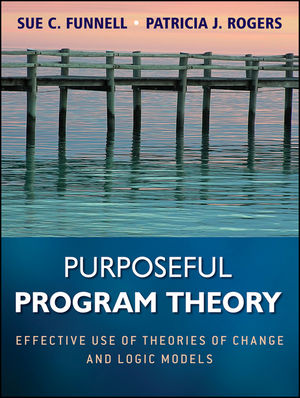Purposeful Program Theory: Effective Use of Theories of Change and Logic ModelsISBN: 978-0-470-47857-8
Paperback
576 pages
March 2011, Jossey-Bass
 |
||||||
Figures, Tables, and Exhibits x
Acknowledgments xv
The Authors xvii
Introduction: The Promise and Risks of Using Program Theory xix
Part One Key Ideas in Program Theory
Chapter 1: The Essence of Program Theory 3
Evaluation Without Program Theory 3
Evaluation with Program Theory 6
Summary 13
Exercises 13
Chapter 2: Variations of Program Theory over Time 15
A Short History of Program Theory 15
Terminology in Program Theory 23
Key Ideas in Program Theory 30
Summary 34
Exercises 35
Chapter 3: Common Myths and Traps 37
Some Common Myths 37
Traps to Avoid When Developing and Using Program Theory 41
Summary 52
Exercises 52
Part Two Assessing Your Circumstances
Chapter 4: Scoping Intended Uses 55
Why Intended Use Matters 55
Using Program Theory 58
Summary 67
Exercises 68
Chapter 5: The Nature of the Situation and the Intervention 69
Simple, Complicated, and Complex 70
Focus 74
Governance 80
Consistency 82
Necessariness 84
Sufficiency 85
Change Trajectory 88
Summary 90
Exercise 91
Part Three Developing and Representing Program Theory
Chapter 6: Processes to Identify or Develop a Program Theory 95
Process Options for Developing Program Theory 95
Decision 1: Who Should Be Involved in Developing a Program Theory, and How? 97
Decision 2: What Is an Appropriate Mix of Approaches for Developing or Eliciting the Program Theory? 101
Decision 3: How Might Workshops and Interviews Be Used in Developing Program Theory? 120
Decision 4: As Challenges Arise, How Should They Be Addressed? 128
Decision 5: How Much Time and Resources Should Be Invested in Developing or Identifying a Program Theory? 141
Decision 6: When Is It Time to Revisit a Program Theory? 144
Summary 147
Exercise 148
Chapter 7: Developing a Theory of Change 149
Features of a Theory of Change 150
Situation Analysis: Understanding the Problem, Its Causes, and Its Consequences 151
Focusing and Scoping 163
Outcomes Chain 176
Summary 195
Exercises 196
Chapter 8: Developing a Theory of Action 199
Preparing the Theory of Action 204
Success Criteria for a Theory of Change 204
Assumptions About Factors That Affect Successful Achievement of Outcomes 217
How to Identify Factors That Are Likely to Affect Outcomes 226
Identifying What the Program Does 229
Pulling the Theory of Change and the Theory of Action Together in a Matrix 235
Summary 237
Exercise 240
Chapter 9: Representing Program Theory 241
Options for Representation 241
Representing Complicated Program Theory 251
Representing Complex Program Theory 264
What Makes a Good Representation of Program Theory 277
Should Logic Models Include SMART Measures? 290
Summary 291
Exercises 292
Chapter 10: Critiquing Program Theory 293
Criteria for Assessing Internal Validity 296
Criteria for External Validation 305
Engaging Stakeholders in the Review 312
Responding to the Results of a Review of a Program Theory 314
Summary 316
Exercise 316
Part Four Resources for Developing Program Theory
Chapter 11: Some Research-Based Theories of Change 319
Theory of Reasoned Action and Theory of Planned Behavior 323
Stages of Change Theory 326
Empowerment Theory 332
Diffusion Theory 335
Socioecological Theory 339
Network Theory 342
Selecting and Using Theories of Change 347
Summary 349
Exercises 349
Chapter 12: Some Common Program Archetypes 351
Some Important Program Archetypes 351
Advisory, Information, and Education Program Archetype 352
Carrots and Sticks Program Archetype 357
Case Management Programs Program Archetype 367
Community Capacity-Building Program Archetype 370
Product or Direct Service Delivery Program Archetype 374
Deciding Which Program Archetype Applies to a Program 381
Summary 385
Exercise 386
Chapter 13: Logic Models Resources 387
Pipeline Logic Models 387
Variations of Outcomes Chain Logic Models 396
Technology for Representing Program Theory 399
Summary 414
Exercise 414
Part Five Using Program Theory for Monitoring and Evaluation
Chapter 14: Developing a Monitoring and Evaluation Plan 417
Using Program Theory for Performance Monitoring 418
Making Choices About What to Measure Within the Program Theory 425
Including Comparisons as Part of the Performance Information System 434
Using Program Theory to Plan an Evaluation 438
Considerations When Using Program Theory to Design Evaluations of Complicated and Complex Programs 455
Summary 466
Exercises 467
Chapter 15: Causal Inference 469
The Need to Be Scientific and Pragmatic 469
A Framework for Causal Analysis Using Program Theory 473
Congruence 474
Counterfactual Comparisons 488
Critical Review 495
Summary 499
Exercises 499
Chapter 16: Synthesis and Reporting 501
Synthesis and Reporting for a Single Evaluation 501
Synthesis and Reporting Across Evaluations 508
Summary 516
Exercises 516
New Frontiers for Program Theory 517
References 519
Index 537



